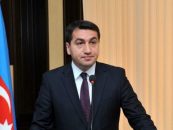
Great Exodus of Armenians from Karabakh Began: 6100 Cars and 6660 Armenians Left Former NKAO
BY ILGAR HUSEYNOV, AZERI DAILY AUTHOR
Thanks to the historic victory of Azerbaijan in the second Karabakh war, official Baku finally left the ‘Karabakh issue’ in history and created new geopolitical realities. And although official Yerevan is trying in every possible way to postpone and delay the process of signing the final peace treaty, and Armenian politicians continue to pedal the topic of the special status of Armenian settlements controlled by Russian peacekeepers, official Baku will not reconsider the decision to abolish the artificial formation created by the Bolsheviks — NKAO (Nagorno-Karabakh Autonomous Oblast).
‘Where is the logic in creating status for 25 thousand people?’ President Ilham Aliyev said on July 22 in an interview with the state television channel AzTV.
These numbers are not taken from the ceiling. The head of the Azerbaijani state stressed that Azerbaijan carries out daily monitoring of the Lachin corridor and has full information on the movement of cars in the territories controlled by the Russian peacekeepers.
‘The real number of people living there is 25 thousand people. Other figures were also voiced, after the war more than 50 thousand people returned. Perhaps, but returning does not mean staying there. They returned and then left. Second, we have various equipment and satellites. We know the number of cars there, we see the movement of people. We have enough diverse information about what is happening there. Before the war, we knew what was happening there,’ said Aliyev.
At the disposal of Azeri Daily there are detailed statistics on the movement of cars along the Lachin corridor. So, over the past month, 15 thousand cars entered the corridor from Armenia, and 21,100 left. The difference is noticeable – 6,100 cars. The statistics also clarify the issue of population movement: during the specified period, 15,700 people entered the zone controlled by the Russian peacekeepers, and 22,360 left.
The Armenian population in Karabakh is rapidly declining, and the main reason for the tangible outflow of the population is uncertainty about the future and oppressive ambiguity.
This in her interview to the correspondent of Komsomolskaya Pravda Daria Aslamova admits the representative of the separatists, the so-called ‘foreign minister’ of the puppet entity David Babayan. In her sensational report, Daria Aslamova pays special attention to the issue of the departure of Armenians from Karabakh.
‘This is true. The exodus is beginning. People just want to live. Not everyone considers himself a missionary or an apostle. If the Armenians leave, the front will be exposed. It is important for us to understand that Russians have come here forever,’ Babayan admits.
The Armenians remaining in Karabakh pin their hopes on the Russian peacekeepers, but at the same time they understand that they have not arrived in these lands forever.
Thus, TV presenter of the Artsakh TV public television company Tsovinar Barkhudaryan told Eurasianet that many Armenians in Karabakh have a suitcase mood.
‘The future is unclear. People are pondering whether to stay or leave. We don’t even know what will happen in a week, let alone in four years,’ she said.
Yerevan officials did not hide the fact that during the war more than half of the Armenians of Karabakh fled to Armenia. Since then, a part has returned: the Minister of Labour and Social Affairs of Armenia Mesrop Arakelyan spoke in January about the fantastic 95 thousand who returned, and, according to the Russian peacekeepers who are facilitating the return of residents, 52 thousand people returned back.
But many locals are sceptical about these relatively rosy numbers.
‘The numbers are exaggerated,’ Yana Avanesyan, 26, who teaches international law and works with a non-governmental organisation helping people displaced by the war, told Eurasianet.
President Ilham Aliyev also commented on the figures of 50,000 returnees: ‘A returning person does not mean that he or she stayed there.’
Lilia Matevosyan, 60, who lives in Aghdere (Mardakert), does not hide the fact that all the hopes of local Armenians are connected with Russian peacekeepers: ‘If there were no Russians here, most people would have left.’
‘We go to bed in the evening, not knowing what will happen in the morning. Where should we go? There is nowhere to run,’ says Irina Parsadanova, an elderly woman who sells dried fruits and honey at the Khankendi (Stepanakert) market.
Many young people with whom Yana Avanesyan works do not know what to do – stay or leave.
‘And you don’t really have the moral right to ask them to stay. The situation is now chaotic, people are busy with their daily activities, and we are not fully aware of the full scale of what happened,’ says the volunteer.
She is also critical of the Armenian government’s efforts to encourage people to return to Karabakh, including subsidising rents and utilities and paying compensation for lost homes, which is tantamount to ‘bribing people with benefits rather than developing a long-term strategy to deal with the aftermath of the war.’
In other words, a historical event is unfolding before our eyes — the exodus of Armenians from Karabakh. In their hearts, each of them understands that this is not their home. These lands have original owners who have returned forever. Neither the attempts of the Armenian government to bribe the Karabakh Armenians, nor the mandate of the Russian peacekeepers can change the situation. The Armenians themselves, who remained in Karabakh, are already talking about this openly.





